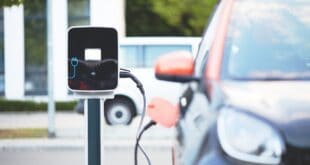
Today, the Sierra Club, along with Pacific Gas & Electric (PG&E), and a diverse coalition of public interest groups, automakers, labor unions, and representatives of community choice aggregators and electric vehicle (EV) charging, submitted a proposed settlement to the California Public Utilities Commission to accelerate the deployment of EV charging stations across Northern California. The new “Charge Smart and Save” program, if adopted by the Commission, would bring the state one step closer to meeting its ambitious EV goals, which include infrastructure to support 1 million zero-emission vehicles by 2020, and 1.5 million vehicles on California roads by 2025.
Under the settlement, PG&E’s modified “Charge Smart and Save” program would add about 7,500 Level 2 charging ports and 100 Direct Current (DC) Fast Chargers to the grid over three years. DC fast chargers, which can charge an EV in 20 to 30 minutes, will be strategically located to facilitate on-the-go charging. Level 2 charging stations supply lower power, on par with an electric oven, and can fully charge a car in four to eight hours. The Level 2 charging infrastructure would be primarily installed at workplaces and multi-family dwellings—like apartment buildings and condominium complexes—across PG&E’s service territory.
By locating most Level 2 charging stations at workplaces and multi-family dwellings, the program targets two critical market gaps. Workplace charging can be scarce, and yet it is the second most likely place for EV drivers to charge their cars after their homes. Similarly, apartment dwellers often lack access to an outlet or garage, limiting EV ownership in higher density urban areas that could most benefit from cleaner transportation. The modified “Charge Smart and Save” program would also deploy 15 percent of stations in disadvantaged communities across PG&E’s territory, improving access to clean transportation options.
At charging sites, EV drivers would have access to a range of charging equipment options and rates, promoting competition and growth in the EV charging service industry. At the same time, the prices would maximize fuel cost savings for EV drivers. “Charge Smart and Save” has a built-in price signal that encourages customers to charge their EVs at night (when energy prices are low) and discourages charging in the early evening (when demand on the grid is high). To further leverage the new electricity demand, PG&E will implement an advanced program to use EVs to facilitate the integration of renewable energy and to support a reliable and efficient grid.
“Hard work and compromise among diverse parties created a program that will benefit the electricity grid, all utility customers, and the environment,” said Sierra Club attorney Joe Halso. “We commend all involved this process and are proud to support a program that would harness utility resources to improve access to electric vehicle charging while protecting a competitive marketplace. ”
The California Public Utilities Commission is expected to make a decision on the proposed settlement within a year. In a second phase of the program, PG&E would aim to increase the total number of chargers to 25,000, building on lessons learned during the initial deployment.
In addition to the Sierra Club and PG&E, the proposed settlement was negotiated and signed by Natural Resources Defense Council, Greenlining Institute, California Coalition of Utility Employees, Plug In America, General Motors, Honda Motors, the Alliance of Automobile Manufacturers, Center for Sustainable Energy, Greenlots, Marin Clean Energy, Sonoma Clean Power Authority, and Vote Solar.
 Alternative Energy HQ solar power for homes, wind energy, and bio fuel issues
Alternative Energy HQ solar power for homes, wind energy, and bio fuel issues






